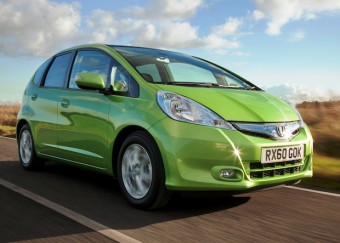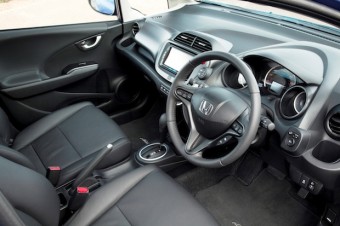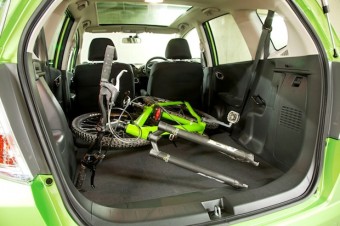 The Jazz roomy supermini is currently Honda’s best selling model range in the UK with a 28,000 annual sales target and with 70 per cent going to retail customers.
The Jazz roomy supermini is currently Honda’s best selling model range in the UK with a 28,000 annual sales target and with 70 per cent going to retail customers.
Over 220,000 of them have been sold in the UK since its launch in 2002.
Prices range £11,605 to £18,750 for the petrol powered 1.2/1.4-litre British built models.
But there is the option of the Jazz Hybrid built in Japan with its 1.3-litre IMA petrol/electric powertrain with prices ranging from £16,300 to £19,335. I recently had a longer and I have to say enjoyable spell in the Jazz Hybrid, not the best selling version because of its high purchase price but they do save money on running costs. For owners it is just a case of doing the sums.
Another financial consideration for some owners is the all important feature of an automatic transmission. The Jazz Hybrid has a CVT auto as standard. This is not available for the 1.2-litre models and as extra £1,100 cost option for 1.4-litre versions.
The base model 1.4-litre with auto costs £14,850 while the least expense Jazz Hybrid with auto as standard costs £16,300. So its price premium is down to just £1,450 and that can be recouped against petrol power only models with savings on fuel use and lower taxes although the forecast residual values for the Hybrid are currently around one to two per cent less. It really is get your calculator out to determine the best personal option when it comes to other comparisons such as running costs and performance.
 The official figures show the Jazz Hybrid 1.3-litre/electric assist version will return 62.8mpg in the Combined Cycle with CO2 emissions of 104g/km meaning road tax is £0 for the First Year rate then, as an alternatively fuelled car, £10 per annum. Company car drivers will pay 11 per cent in BIK tax. The 1.2-litre Jazz by comparison does 53.3mpg, CO2 output is 123g/km, road tax is £0 then £100 for the second year onwards and BIK is 15 per cent. The most popular 1.4-litre versions return 51.4mpg, CO2 ranges from 125 to 129g/km so the road tax and BIK is the same as the 1.2 version. The 1.2 models are cheapest to insure with a group 13E rating whilst the hybrid and 1.4 versions are rated at 16E.
The official figures show the Jazz Hybrid 1.3-litre/electric assist version will return 62.8mpg in the Combined Cycle with CO2 emissions of 104g/km meaning road tax is £0 for the First Year rate then, as an alternatively fuelled car, £10 per annum. Company car drivers will pay 11 per cent in BIK tax. The 1.2-litre Jazz by comparison does 53.3mpg, CO2 output is 123g/km, road tax is £0 then £100 for the second year onwards and BIK is 15 per cent. The most popular 1.4-litre versions return 51.4mpg, CO2 ranges from 125 to 129g/km so the road tax and BIK is the same as the 1.2 version. The 1.2 models are cheapest to insure with a group 13E rating whilst the hybrid and 1.4 versions are rated at 16E.
When it comes to performance the 1.2-litre Jazz offers 89bhp and 84 lb ft of torque with a top speed of 110mph and zero to 62mph in 12.5 seconds. The 1.4-litre offers 97bhp and 94lb ft of torque, 111mph and 0-62mph in 11 seconds. The 1.3-litre Hybrid has the combined petrol engine and electric motor figures of 100bhp, 147lb ft of torque, 109mph and 0 to 62mph in 12.1 seconds.
The hybrid system with its extra torque also smoothes out the gearchange steps from the 6-speed CVT transmission and the engine doesn’t sound stressed under acceleration, a typical feature of CVTs.
My test drive in the Jazz Hybrid, using mainly its ECO setting mode and covering the usual motorway journeys and trips into town plus country lane use, was an impressive 54.4mpg. This is not close to the official figure but better in real-life conditions than I would get from the 1.2/1.4-litre petrol models.
For private motorists where an automatic transmission is a requirement, the Hybrid is the most logical version of the Jazz to buy new. Buying one several years old is unlikely to be an issue because Honda is known for reliability and longevity for all its products but you never know with relatively new technologies and I wouldn’t want to be incurring battery/electric motor/generator repair or replacement costs.
There are a couple of other less positive conclusions regarding the Jazz Hybrid. It is a fairly simple hybrid system with the electric motor element only involved in boosting power as an assist to the petrol engine and giving an increase in performance and improving fuel economy. It still doesn’t get the car into the sub 100g/km which would remove it from road tax cost all together. It doesn’t have the facility or battery capacity to select to run the Jazz Hybrid in electric vehicle only mode for zero emission zones although it can run the car automatically in electric power only for a very short distance if the conditions are right.
 Hybrid technology is moving on at a brisk pace and we see sub 100g/km versions, we have models that can be used in electric power only and we are just seeing newer Hybrids which can use electric power to really boost out-and-out performance and can be used at greater speeds on open roads.
Hybrid technology is moving on at a brisk pace and we see sub 100g/km versions, we have models that can be used in electric power only and we are just seeing newer Hybrids which can use electric power to really boost out-and-out performance and can be used at greater speeds on open roads.
We are also seeing Hybrids with an electric plug-in facility where a charge from the mains further extends the hybrid’s capabilities.
Needless to say models with these more complex hybrid systems cost more to buy. For the Japanese and USA markets Honda will introduce a plug-in electric power only version.
Moving on to the Jazz in whatever propulsion form as a useable family car. The Jazz five-door covers two areas of the market for Honda, the conventional five door supermini hatchback selling against the Fiesta, Corsa and Polo and others. Because of its high roof, upright seating and easy fold down rear seats it competes in the growing compact people carrier or multi-purpose sector against the new Ford B-Max and Vauxhall Meriva. It doesn’t have the unrestricted side access of those two with their wide opening doors with no B-pillar, it has conventional hinged side doors. But inside it offers a long wheelbase so there is ample rear seat legroom for two adults and the rear split seats fold down independently to give a large carrying space with a completely flat load floor.
 The Jazz, Honda likes to think, is targeted at young families either as their main transport or as a second car for mum’s family bus duties. In reality, from my experience, it is the older generation ‘empty nesters’ who seem to be the main customers. These people like the easy access, the comfortable seats, the ability to carry whatever long or heavy loads they need, it’s easy to park, it’s reliable and cost effective to run and it looks youthful as well. The less mobile and Motability users can carry whatever walking or transport aids they need in the cavernous load space as well and the automatic transmission is also a significant reason to purchase a Jazz, if not the Hybrid, the 1.4-litre model fits their requirements as well.
The Jazz, Honda likes to think, is targeted at young families either as their main transport or as a second car for mum’s family bus duties. In reality, from my experience, it is the older generation ‘empty nesters’ who seem to be the main customers. These people like the easy access, the comfortable seats, the ability to carry whatever long or heavy loads they need, it’s easy to park, it’s reliable and cost effective to run and it looks youthful as well. The less mobile and Motability users can carry whatever walking or transport aids they need in the cavernous load space as well and the automatic transmission is also a significant reason to purchase a Jazz, if not the Hybrid, the 1.4-litre model fits their requirements as well.
 The ride comfort and handling is generally good for a tall all-purpose vehicle but it can become a bit unsettled over poorer road surfaces and it is prone to side wind gusting. It more than holds its own at high motorway cruising speeds and it is nippy and agile in heavy town traffic plus it’s easy to park. It is not particularly engaging to drive but it does the job intended without fuss, its Jazz ok but without very much Soul.
The ride comfort and handling is generally good for a tall all-purpose vehicle but it can become a bit unsettled over poorer road surfaces and it is prone to side wind gusting. It more than holds its own at high motorway cruising speeds and it is nippy and agile in heavy town traffic plus it’s easy to park. It is not particularly engaging to drive but it does the job intended without fuss, its Jazz ok but without very much Soul.
As for fixtures and fittings, my Jazz Hybrid had the mid range HS specification and is priced at £16,810.
For this money the specification includes 15-inch alloy wheels, automatic climate control, cruise control, electric windows and door mirrors, fabric upholstery, front fog lights, loads of front, side and curtain airbags, height adjustable front seats, adjustable steering column, on-board computer, paddle shift gear change, remote central locking and much more.
As a prompt to driving economically the well positioned instrument panel glows green.
MILESTONES
Honda Jazz 1.3 i-VTEC IMA HS HYBRID CVT 5-Door £16,810.
Engine/IMA Hybrid system and transmission: 1.3-litre, 4-cylinder petrol and electric motor with 100bhp combined power and 147lb ft of torque, 6-speed CVT auto transmission. Performance: 109mph, 0-62mph 12.1 seconds 62.8mpg Combined Cycle, (54.4mpg on test), CO2 104g/km. VED road tax £0 First Year rate then £10 second year onwards, BIK company car tax 11%. Insurance group: 16E. Dimensions/capacities: L 3,900mm, H 1,525mm, W 1,695mm, boot/load space 300 to 1,320-litres. Warranty: Car 3-years/90,000 miles, IMA system 5-years/90,000 miles.
For: Roomy, comfortable with high supportive seating, easy to get in and out, clever ‘magic’ seating combinations and large load area with a flat floor, fuel and CO2 efficient, low taxes, agile, easy to park.
Against: More pricey to buy than petrol only models, unsettled ride quality, no facility or battery capacity to select EV driving mode only, does not get under the important 100g/km CO2 level, no spare wheel – no space for it, a bit Soul-less to drive.


